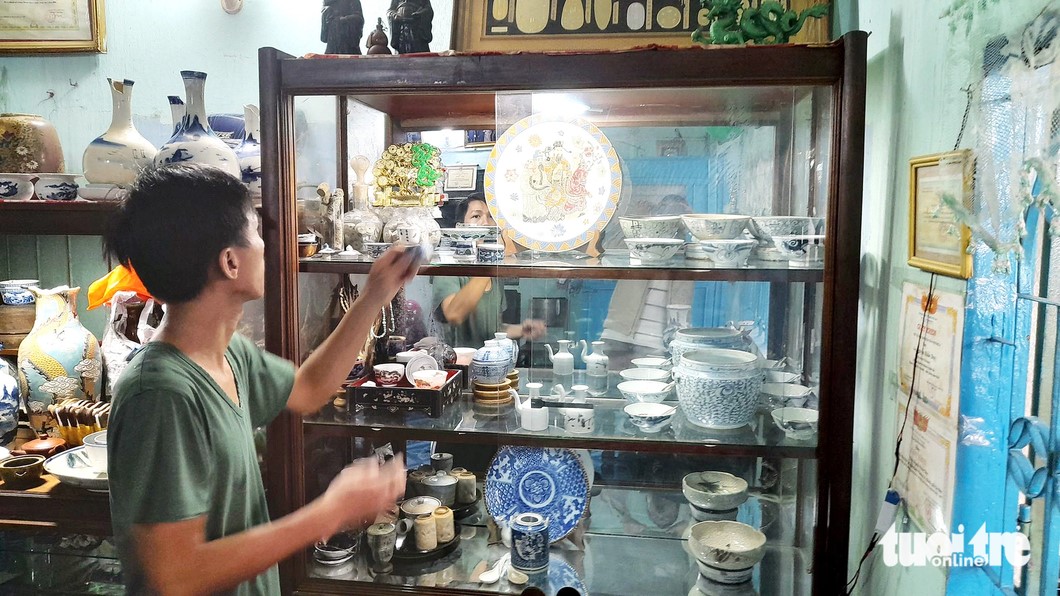Fifteen years ago, the man, who is now 34 years old and resides in Sa Dec City in the Mekong Delta province of Dong Thap, returned to his hometown after completing his military service. He then joined his family business of trading artifacts. Realizing that the supply of artifacts was decreasing over time, Duy was determined to find ways to repair damaged items, ensuring the sustainability of their business in the long run.
Reviving the past
In the beginning, Duy lacked confidence in fixing damaged artifacts, so he only repaired his own pieces to avoid causing further harm to his customers’ valuable items. However, as he gained more experience and repaired more artifacts, he began receiving requests from collectors to mend their damaged pieces.
“Repairing broken artifacts involves several stages,” Duy explained. “First, I mix the glue to apply to the missing part of the artifact. Once the glue is dry, I start restoring the shape of the lost or broken parts. Then, I use sandpaper and a sander to remove the excess glue and make the repaired parts look like the original. In the next step, I paint over the repaired part and match the patterns of the missing section. Finally, I apply a layer of paint to protect the repaired part and make it blend in with the rest of the artifact.”
Although some people may think that Duy’s work is easy because the artifacts can be restored after a few steps, he emphasizes that it is a time-consuming process that requires utmost attention and patience. Each step in the repair process plays a crucial role, such as using the right amount of glue to ensure the broken parts adhere properly without easily falling apart under physical forces. The sanding process must also be done gently to achieve a smooth and flawless finish.
Duy finds the color-mixing step to be the most time-consuming since he needs to find the most suitable color that matches the original artifact. He has learned through experience that the paint color can change as it dries, so he often has to start over multiple times until he achieves the desired color.
Depending on the extent of the damage, Duy may need a day or more to complete the repair. Each old or antique object has its own story, allowing Duy to reminisce about fond memories as he works on them.
“There was a customer who brought me a vase from the 19th century that was completely broken,” Duy recalled. “When I managed to restore it to its original condition, it felt like giving it a second life. The customer was grateful for the repair and presented me with many gifts.”
Duy regrets seeing broken or damaged artifacts and constantly thinks of ways to restore them. He takes pride in contributing to the preservation of the dwindling world of artifacts by returning them to their original state.
|
|
| The artifacts that were repaired by Duy. Photo: Chung Thanh Huy / Tuoi Tre |
Promoting timeless value
Looking at the artifacts repaired by Duy, it is hard to imagine that they were once damaged. Duy’s meticulous care for ancient artifacts reflects his passion and dedication to this highly specialized work.
“When customers entrust me with their damaged objects, I take great pride in my work. Seeing their items perfectly restored gives me a sense of accomplishment,” he said.
“Every artifact is unique. One day I may repair a broken bowl, while the next day it could be a kettle with a shattered spout. It is the variety of requirements that keeps me engaged, preventing any boredom.”
Repairing ancient artifacts requires a wide range of skills. Apart from mastering chemical knowledge to mix the right ingredients for reshaping and coloring, experts like Duy must possess artistic talents to recreate lost patterns or details and have an archeological understanding to recreate the “colors of time” that resemble those of the past. Sadly, the number of experts in this field has been declining over time.
“To do this job, one needs patience, skill, and an appreciation for aesthetics,” Duy explained. “Without these qualities, it becomes challenging to excel in this field. Patience is crucial when waiting for the glue to dry, even if it means accepting initial failure. I have experienced many failures, especially in the color mixing phase, where it often takes numerous attempts and adjustments before achieving the desired color closest to the original.”
Local authorities once offered Duy the opportunity to hold events at his home to attract visitors and promote the local tourism industry. However, Duy found it challenging to concentrate while working in front of crowds. Additionally, the dust generated during the artifact cleaning process poses health risks, leading Duy to decline the offer temporarily.
Nevertheless, Duy still takes the time to meet and educate people interested in his unique profession. He hopes to pass on the ancient values encapsulated in these old objects.
“I take pride in being honest with my customers. When they entrust me with their damaged artifacts, I always inform them that while I strive to restore the objects to their original condition, perfection cannot be guaranteed. I aim for around 80-90% restoration,” Duy said.
“Fortunately, most customers appreciate the repaired artifacts, even if they do not look identical to the originals. As someone working in the cultural sector, I strive to preserve the historical values and share them with today’s generation.”
However, Duy acknowledges that the market for artifacts can be complicated, with many people skeptical about the repair process. Some individuals even exploit repairs to deceive others and turn damaged antiquities into valuable items. Nonetheless, Duy remains true to his principles and maintains integrity in his daily work.
Avoiding aiding fraud
Q.T., an ancient artifact collector from Sa Dec City, highly regards Duy’s honesty and expertise.
“Duy is an admirable person because he is always honest and transparent,” Q.T. said. “When he repairs a damaged artifact, he charges a fair amount for his work, regardless of the item’s owner or value.”
“He has even refused orders from people who wanted him to create fake items for illegal profits.”




